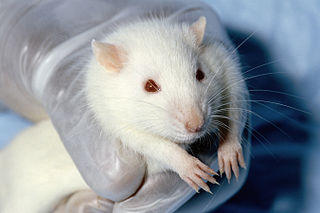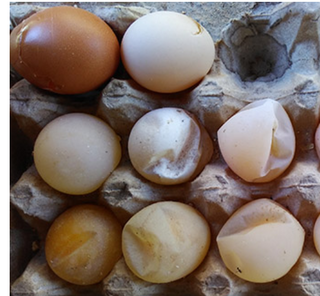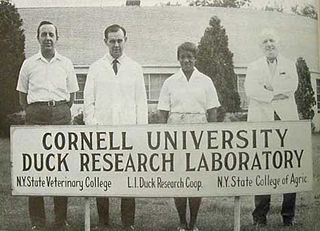
Virulent Newcastle disease (VND), formerly exotic Newcastle disease, is a contagious viral avian disease affecting many domestic and wild bird species; it is transmissible to humans. Though it can infect humans, most cases are non-symptomatic; rarely it can cause a mild fever and influenza-like symptoms and/or conjunctivitis in humans. Its effects are most notable in domestic poultry due to their high susceptibility and the potential for severe impacts of an epizootic on the poultry industries. It is endemic to many countries. No treatment for VND is known, but the use of prophylactic vaccines and sanitary measures reduces the likelihood of outbreaks.
The Pirbright Institute is a research institute in Surrey, England, dedicated to the study of infectious diseases of farm animals. It forms part of the UK government's Biotechnology and Biological Sciences Research Council (BBSRC). The institute employs scientists, vets, PhD students and operations staff.
Coccidiosis is a parasitic disease of the intestinal tract of animals caused by coccidian protozoa. The disease spreads from one animal to another by contact with infected feces or ingestion of infected tissue. Diarrhea, which may become bloody in severe cases, is the primary symptom. Most animals infected with coccidia are asymptomatic, but young or immunocompromised animals may suffer severe symptoms and death.

Eimeria tenella is a species of Eimeria that causes hemorrhagic cecal coccidiosis in young poultry. It is found worldwide.

Eimeria is a genus of apicomplexan parasites that includes various species capable of causing the disease coccidiosis in animals such as cattle, poultry and smaller ruminants including sheep and goats. Eimeria species are considered to be monoxenous because the life cycle is completed within a single host, and stenoxenous because they tend to be host specific, although a number of exceptions have been identified. Species of this genus infect a wide variety of hosts. Thirty-one species are known to occur in bats (Chiroptera), two in turtles, and 130 named species infect fish. Two species infect seals. Five species infect llamas and alpacas: E. alpacae, E. ivitaensis, E. lamae, E. macusaniensis, and E. punonensis. A number of species infect rodents, including E. couesii, E. kinsellai, E. palustris, E. ojastii and E. oryzomysi. Others infect poultry, rabbits and cattle. For full species list, see below.
Poultry diseases occur in poultry, which are domesticated birds kept for their meat, eggs or feathers. Poultry species include the chicken, turkey, duck, goose and ostrich.
Marek's disease is a highly contagious viral neoplastic disease in chickens. It is named after József Marek, a Hungarian veterinarian who described it in 1907. Marek's disease is caused by an alphaherpesvirus known as "Marek's disease virus" (MDV) or Gallid alphaherpesvirus 2 (GaHV-2). The disease is characterized by the presence of T cell lymphoma as well as infiltration of nerves and organs by lymphocytes. Viruses related to MDV appear to be benign and can be used as vaccine strains to prevent Marek's disease. For example, the related herpesvirus found in turkeys (HVT), causes no apparent disease in the birds, and continues to be used as a vaccine strain for prevention of Marek's disease.

Gallid alphaherpesvirus 1 (GaHV-1) is a species of virus in the order Herpesvirales, family Herpesviridae, subfamily Alphaherpesvirinae, and genus Iltovirus. Originally recognised in chickens in the United States in 1926, this virus causes avian infectious laryngotracheitis, a potentially fatal, economically deleterious disease, widely recognised as one of the most contagious diseases in the poultry industry. The virus and its associated disease also occur in pheasants.

Lymphoid leucosis is a disease that affects chickens, caused by the retrovirus Avian leukosis virus.
Leucosis is a leukemia-like malignant viral disease that is found in animals, particularly poultry and cattle.

Specific-pathogen-free (SPF) is a term used for laboratory animals that are guaranteed free of particular pathogens. Use of SPF animals ensures that specified diseases do not interfere with an experiment. For example, absence of respiratory pathogens such as influenza is desirable when investigating a drug's effect on lung function.

Argas persicus, also known as fowl tick or poultry tick, is a small soft-bodied tick that is found primarily on domestic fowl such as chickens, ducks, and geese. It was first recorded by Lorenz Oken in 1818 in Mianeh, Persia, and named Rhynochoprion persicum.
Avian sarcoma leukosis virus (ASLV) is an endogenous retrovirus that infects and can lead to cancer in chickens; experimentally it can infect other species of birds and mammals. ASLV replicates in chicken embryo fibroblasts, the cells that contribute to the formation of connective tissues. Different forms of the disease exist, including lymphoblastic, erythroblastic, and osteopetrotic.
ATCvet code QI01Immunologicals for Aves is a therapeutic subgroup of the Anatomical Therapeutic Chemical Classification System for veterinary medicinal products, a system of alphanumeric codes developed by the World Health Organization (WHO) for the classification of drugs and other medical products for veterinary use. Subgroup QI01 is part of the anatomical group QI Immunologicals.
Pacheco's disease is a highly infectious and acute bird disease caused by a species of herpesvirus, Psittacid alphaherpesvirus 1 (PsHV-1). All psittacine species are susceptible to Pacheco's disease, mainly those in zoological collections and aviaries in any geographic regions. Specifically, Pacheco's disease has a high occurrence rate in Amazon parrots, followed by African grey parrots, parrots, macaws, cockatoos and conures. Due to a very high mortality rate within these susceptible species, concerns are brought to companion bird markets and breeders.
The avian immune system is the system of biological structures and cellular processes that protects birds from disease.

Egg drop syndrome '76 is a viral disease that affects birds, notably chickens, ducks, geese and swans. It is characterised by a sudden drop in production of eggs as well as its eggshell quality in apparent healthy laying birds.
Reticuloendotheliosis (RE) designates a group of pathologic syndromes caused by the reticuloendotheliosis virus (REV) group of avian retroviruses. The disease syndromes associated with REV include 1) a runting disease syndrome, 2) chronic neoplasia of lymphoid and other tissues, and 3) acute reticulum cell neoplasia.

Jessie Isabelle Price was a veterinary microbiologist. She isolated and reproduced the cause of the most common life-threatening disease in duck farming in the 1950s and developed vaccines for this and other avian diseases. A graduate of Cornell University, where she gained a PhD (1959), she worked first at the Cornell Duck Research Laboratory and later at the USGS National Wildlife Health Center. She served as chair of the Predoctoral Minority Fellowship Ad Hoc Review Committee of the American Society for Microbiology (ASM), and as president of Graduate Women in Science.
The National Veterinary Research Institute (NVRI) is a research institute in Nigeria that was established in 1924 and has the mandate to conduct research into how to ably identify, treat and control animal diseases as well as the development of vaccines for such and training and the provision of support services to livestock and poultry farmers. The institute is under the supervision of Federal Ministry of Agriculture and Rural Development. The chief executive is Maryam Muhammad, a veterinary doctor with research interests in the molecular epidemiology of Salmonella in poultry, public health and environment and development.











